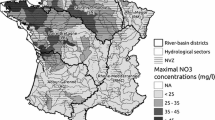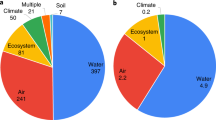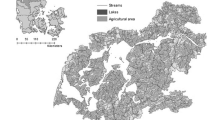Abstract
The purpose of this paper is to describe a nitrogen-based deposit-refund system for regulating non-point nitrogen emissions from agriculture. I develop a formal model of a polluting production sector with substance content of inputs and outputs as an explicit quality dimension. Within this framework two input-output based tax schemes for regulation of agricultural nitrogen emissions are compared, while taking regulator monitoring costs into account. Incentive regulation of nitrogen emissions from Danish agriculture is discussed in this light. It is concluded that a nitrogen-based deposit-refund system seems a logical focal point of analysis for a policymaker considering introduction of incentive regulation of non-point nitrogen emissions from agriculture.
Similar content being viewed by others
References
Böhm P (1981) Deposit-Refund Systems—Theory and Applications to Environmental, Conservation, and Consumer Policy, John Hopkins University Press, Baltimore
Böhm P, Russell C (1985) Comparative analysis of alternative policy instruments. In: Kneese AV, Sweeney JL (eds) Handbook of energy and environmental economics, vol 1, North Holland, Amsterdam
Brouwer FM, Godeschalk FE, Hellegers PJGJ, Kelholt HJ (1995) Mineral balances at farm level in the European Union, Onderzoekverslag 137, LEI-DLO, Den Haag
Dosi C, Tomasi T (1994) Nonpoint source pollution regulation: issues and analysis. Kluwer Academic, Dordrecht
Dubgaard A (1991) The Danish nitrate policy in the 80’s: SJI-rapport nr. 59. SJI, Copenhagen
Fenger J, Laut P (1989) Drivhuseffekten: Global luftforurening og klimaændringer, Fiskers, Copenhagen
Fontein PF, Thijssen GJ, Magnus JR, Dijk J (1994) On levies to reduce the nitrogen surplus: the case of Dutch pig farms. Environmental and Resource Economics 4:455–478
Gundersen P (1989) Luftforurening med Kvælstofforbindelser—effekter i nåleskov. DTU, Copenhagen
Hansen LG (1998) A damage based tax mechanism for regulation of non-point emissions. Environmental and Resource Economics, 12:99–112
Hansen S, Jensen HE, Nielsen NE, Svendsen H (1990) DAISY—Soil Plant Atmosphere System Model: NPO-forskning nr. A10. Miljøstyrelsen, Copenhagen
Holtermann S (1976) Alternative tax systems to correct for externalities, and the efficiency of paying compensation. Economica 43:1–16
Horan RD, Shortle JS, Abler DG (1998) Ambient taxes when polluters have multiple choices. Journal of Environmental Economics and Management 36:186–199
Huang W, LeBlanc M (1994) Market-based incentives for addressing non-point water quality problems: a residual nitrogen tax approach. Review of Agricultural Economics 16:427–440
Huppes G (1993) Macro-environmental policy: principals and design. Elsevier Science, Amsterdam
Lind A-M, Debosz K, Djurhuus J, Maag M (1990) Kvælstofomsætning og—transport i to dyrkede j order: NPo-forskning Nr. A9. Miljøstyrelsen, Copenhagen
Linddal M (1998) Konsekvenser af kvælstofafgifter i landbruget—en sektor økonomisk analyse, SJFI-rapport nr. 101. SJFI, Copenhagen
Miljøstyrelsen (1990) Vandmiljø-9O: Redegørelse fra miljøstyrelsen nr. 1. Miljøstyrelsen, Copenhagen
Miljøstyrelsen (1993) Vandmiljø-93: Redegørelse fra miljøstyrelsen nr. 4. Miljøstyrelsen, Copenhagen
OECD (1989) Agricultural and Environmental Policies. OECD, Paris
Rude S (1987) Vandmiljøplanen og landbruget—kvaelstofforbrug og økonomi: SJI-rapport nr. 34. SJI, Copenhagen
Rude S (1991) Kvaelstofgødning i landbruget—behov og udvaskning nu og i fremtiden: SJI-rapport nr. 62. SJI, Copenhagen
Rüssel CS, Shogren JF (eds) (1993) Theory, modelling and experience in the management of non-point source pollution. Kluwer Academic, Boston
Segerson K (1988) Uncertainty and incentives for non-point pollution control. Journal of Environmental Economics and Management 15:87–98
Smith RBW, Tomasi TD (1995) Transaction costs and agricultural nonpoint-source water pollution control policies. Journal of Agricultural and Resource Economics 20:277–290
Xepapadeas AP (1997) Regulation of mineral emissions under asymmetric information. In: Romstad E, Simonsen J, Vatn A (eds) Controlling mineral emissions in European agriculture—economics, policies and the environment, CAB International, Wallingfo
Author information
Authors and Affiliations
About this article
Cite this article
Hansen, L.G. A deposit-refund system applied to non-point nitrogen emissions from agriculture. Environ Econ Policy Stud 2, 231–247 (1999). https://doi.org/10.1007/BF03353913
Received:
Accepted:
Published:
Issue Date:
DOI: https://doi.org/10.1007/BF03353913




